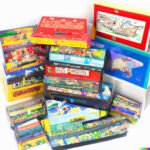Remember the joy of family game nights with classic board games for kids. From Monopoly to Scrabble, these timeless games continue to be popular for good reason. Classic board games offer more than just entertainment; they also provide cognitive development, social skills, and critical thinking for children. In this article, we’ll explore the history and benefits of classic board games, as well as how to choose the right game for your child and introduce them to this beloved pastime.
Classic board games have been a staple in households for generations. The allure of these timeless games lies in their ability to bring families together for fun and bonding. Despite the advent of technology and digital entertainment, classic board games remain a beloved choice for kids and parents. They offer a break from screens and provide an opportunity for face-to-face interaction within the family.
The benefits of classic board games extend beyond mere amusement. These games stimulate cognitive development by encouraging strategic thinking, decision-making, and problem-solving skills in children. Additionally, playing these games promotes social skills such as teamwork, communication, and sportsmanship. By introducing children to classic board games at an early age, parents can cultivate essential life skills while creating lasting memories with their kids.
Benefits of Classic Board Games for Kids
Classic board games for kids have been a staple in households for decades, and their enduring popularity can be attributed to the many benefits they offer to children. One of the key advantages of classic board games is their positive impact on cognitive development. Games like Monopoly and Scrabble require players to strategize, think critically, and make decisions, all of which are essential skills for cognitive growth in children.
In addition to cognitive development, classic board games also help children enhance their social skills. Whether it’s taking turns, communicating with other players, or working as a team to achieve a common goal, these games provide valuable opportunities for kids to practice important social interactions in a fun and engaging way. Furthermore, classic board games encourage critical thinking and problem-solving as children learn to analyze situations, predict outcomes, and come up with solutions while playing.
Research has shown that engaging in classic board games from an early age can have long-lasting positive effects on a child’s overall development. With the numerous benefits they offer, it’s no wonder that classic board games continue to be a popular choice for parents and educators seeking enriching activities for children.
| Benefits | Description |
|---|---|
| Cognitive development | Enhances critical thinking and decision-making skills |
| Social skills | Encourages teamwork, communication, and turn-taking |
| Critical thinking and problem-solving | Promotes analytical thinking and strategizing |
Top 5 Classic Board Games for Kids
Classic board games have stood the test of time and continue to be popular among kids, offering timeless entertainment and educational benefits. Here are the top 5 classic board games for kids that have been beloved for generations:
- Monopoly: This iconic game teaches kids about money management, negotiation, and strategic thinking as they buy properties, collect rent, and build their empire on the game board.
- Scrabble: As a word game, Scrabble helps kids improve their vocabulary, spelling, and critical thinking skills as they form words with letter tiles to score points.
- Candy Land: Perfect for younger children, Candy Land is a colorful and simple game that teaches them about following directions, taking turns, and matching colors as they journey through a sweet-themed world.
- Chutes and Ladders: This classic counting game reinforces basic math skills while also teaching children about consequences as they climb up ladders or slide down chutes based on the outcome of their spins.
- Sorry.: Another classic board game that involves strategy and luck, Sorry. challenges kids to move their pawns around the board while trying to send opponents’ pieces back to the start. This game encourages strategic thinking and good sportsmanship.
These classic board games not only provide fun entertainment for kids but also offer valuable learning opportunities in various aspects such as decision-making, social interaction, problem-solving, and more. Introducing these timeless games to children can help them develop important skills while creating lasting memories with family and friends.
Classic Board Games for Different Age Groups
Classic board games are not just limited to one age group. There are plenty of options available for kids of all ages, from preschoolers to tweens. Each age group has its own set of classic board games that cater to their specific developmental needs and interests.
For preschoolers, simple and colorful games like Candy Land and Chutes and Ladders are perfect choices. These games help young children learn about taking turns, following rules, and counting spaces on the game board. They also feature engaging visuals and easy-to-understand gameplay that keeps the little ones entertained while learning important skills.
Elementary school-aged kids can enjoy classic board games like Monopoly Junior and Scrabble Junior. These junior versions of the popular adult games are designed to be more accessible to younger players, with simplified rules and shorter gameplay duration. They encourage strategic thinking, vocabulary building, basic math skills, and decision-making in a fun and interactive way.
As kids enter their tween years, they may be ready for more complex classic board games such as the original Monopoly or Sorry. These games offer more intricate strategies, longer playtimes, and deeper social interactions. They provide tweens with opportunities to practice negotiation skills, critical thinking, patience, and sportsmanship while having a great time with family or friends.
By understanding the different classic board game options available for each age group, parents can choose the best games that align with their child’s developmental stage and interests. Introducing these timeless games at an early age can help foster a love for tabletop gaming while promoting valuable skills that will benefit kids as they grow older.
How to Choose the Right Classic Board Game for Your Child
When choosing the right classic board game for your child, it’s important to take their age and skill level into consideration. Younger children may struggle with games that require a lot of reading or complex strategic thinking, while older kids might find simpler games too easy and boring.
It’s also important to consider their interests and themes they enjoy. Choosing a game based on a theme they love, such as animals or fantasy, can make the gaming experience more enjoyable for them.
Considering Age and Skill Level
For preschoolers, simple games like Candy Land or Chutes and Ladders are great choices as they focus more on luck rather than strategy. As kids get older, they can graduate to games like Monopoly or Scrabble which require more critical thinking and decision making. It’s important to select a game that matches your child’s abilities to keep them engaged without overwhelming them.
Choosing Games Based on Interests and Themes
If your child loves animals, consider games like Animal Upon Animal or Zooloretto Junior. For those interested in mystery and detective stories, Clue Junior is a great option. By selecting games based on their interests, you can ensure that they will be excited to play.
Multiplayer vs. Single-Player Games
Consider whether your child prefers playing alone or with others. Multiplayer games can help develop social skills such as teamwork and communication, while single-player games can help improve concentration and problem-solving skills. Make sure to choose games that align with your child’s preferences for a more enjoyable experience.
Tips for Introducing Classic Board Games to Kids
Introducing classic board games to kids can be an exciting and rewarding experience for both parents and children. However, it is important to approach the introduction of these games with the right mindset and strategies in order to make the experience enjoyable and beneficial for the kids.
Making It Fun and Engaging
One of the most important aspects of introducing classic board games to kids is to ensure that the experience is fun and engaging. This can be achieved by choosing games that are age-appropriate and align with the child’s interests. Additionally, incorporating elements of storytelling or friendly competition can make the game more exciting for kids.
Setting Up Game Nights for the Family
Another effective way of introducing classic board games to kids is by setting up regular game nights for the whole family. This not only creates a bonding opportunity but also helps in establishing a positive association with board games. Game nights can become a tradition that children look forward to, fostering a love for these timeless classics.
Teaching Kids How to Play and Follow Rules
Lastly, it is essential to take the time to teach kids how to play classic board games and instill in them the importance of following rules. By explaining game instructions clearly and patiently, children can better understand how to play, leading to a more enjoyable experience overall. Furthermore, learning how to follow rules helps in developing discipline and good sportsmanship in kids.
DIY Versions of Classic Board Games for Kids
For parents looking to add a personal touch to their children’s gaming experience, creating DIY versions of classic board games can be a fun and rewarding activity. By making your own Candy Land or Chutes and Ladders, you not only customize the game to your child’s preferences but also encourage creativity and resourcefulness. Additionally, these DIY projects can be cost-effective and provide an opportunity for quality bonding time with your kids.
One way to create your own version of classic board games is by using everyday materials found at home. For example, for a homemade Candy Land game, colorful construction paper can be used to create the game board while small trinkets or toys can serve as player pieces. Similarly, for a DIY Chutes and Ladders game, cardboard and markers can be used to draw the different spaces on the board and create the ladder and chute elements.
Another option for crafting DIY versions of classic board games is by repurposing old or unused materials. For instance, if you have an outdated puzzle that is missing some pieces, you can repurpose the puzzle board by turning it into a Scrabble game board. This not only gives new life to old items but also encourages sustainability by reducing waste.
By creating your own DIY versions of classic board games, you instill a sense of creativity and resourcefulness in your children. It also provides an opportunity for them to take pride in their own handmade creations while enjoying timeless classics that have been loved by generations before them.
Resources for Purchasing Classic Board Games for Kids
When it comes to purchasing classic board games for kids, there are a variety of resources available to parents and caregivers. Whether you prefer the convenience of online shopping or enjoy the experience of browsing through a local toy store, you have plenty of options to choose from. Here are some resources for purchasing classic board games for kids:
- Online retailers: Websites such as Amazon, Target, and Walmart offer a wide selection of classic board games for kids. You can easily compare prices and read reviews from other customers to make an informed decision.
- Local toy stores: Visiting a local toy store can be a great way to support small businesses in your community. Many specialty toy stores carry a curated selection of classic board games that you may not find in larger chain stores.
- Secondhand options and thrift stores: If you’re looking to save money or find rare and out-of-print games, consider checking out secondhand options such as eBay, Craigslist, or thrift stores. You might stumble upon hidden gems at affordable prices.
By exploring these different resources, you can find the perfect classic board game for your child’s interests and skill level. Whether you’re looking for educational games that promote literacy and math skills, or simply want to introduce your child to timeless favorites from your own childhood, there’s a classic board game out there for every family.
Remember that playing classic board games with your child is not only fun but also offers valuable learning opportunities. It’s never too early to start building memories and teaching important skills through the act of play.
Conclusion
In conclusion, classic board games for kids have stood the test of time for a reason. Not only do they provide hours of entertainment, but they also offer numerous benefits for children’s development. From cognitive skills to social interaction and critical thinking, these games have a lot to offer young players.
It’s important for parents to consider the age and skill level of their child when choosing classic board games. From preschoolers to tweens, there are games tailored to each age group that can provide both fun and educational value. By considering your child’s interests and choosing games with themes that appeal to them, you can ensure that they will be engaged and interested in playing.
Introducing classic board games to kids can also be a great opportunity for family bonding. Game nights not only provide quality time together but also teach children important skills like following rules and good sportsmanship. Therefore, it’s highly encouraged for parents to introduce these timeless games to their children as a way to foster both learning and fun in a family setting.
Frequently Asked Questions
What Are 5 Classic Family Games?
Classic family games include Monopoly, Scrabble, Uno, Sorry!, and Clue. These games have been enjoyed by families for generations and are often considered staples in a game collection.
What Is the Main Classic Board Game?
The main classic board game is arguably Chess. This game has a rich history dating back centuries and is known for its strategic gameplay that has captured the interest of players around the world.
What Is the Most Popular Traditional Board Game?
The most popular traditional board game is likely to be Checkers (also known as Draughts). This simple yet engaging game is easy to learn but provides endless entertainment as players try to outmaneuver each other on the board. Its accessibility and universal appeal have contributed to its enduring popularity.

I love playing all kinds of games – from classics like Monopoly to modern favourites like Ticket to Ride.
I created this blog as a way to share my love of board games with others, and provide information on the latest releases and news in the industry.





